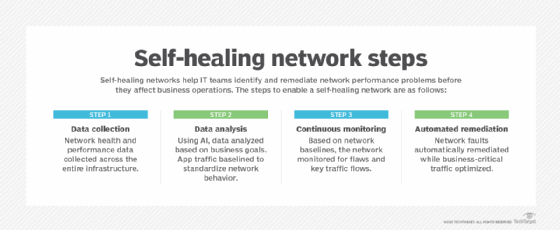
Getty Images
Self-healing networks goals, benefits and how they work
With help from automation and AI, self-healing networks promise to detect, remediate and even predict network problems. But can these systems be trusted?
In the IT world, there's some confusion about what self-healing networks are -- and what they are not. After all, enterprise networks have been self-healing for decades, right?
The answer to that question depends on today's definition of a self-healing network and what technologies are available to facilitate the self-healing process. Let's learn what a self-healing network is now, how it works and the benefits that can be gained.
What is a self-healing network?
Traditional enterprise networks were originally architected to fail over automatically to standby hardware and associated backup links when physical or logical failures occurred. However, the techniques used for this type of redundancy were relatively rudimentary and had no visibility into the type of traffic flows that were affected.
By today's standards, self-healing networks go far beyond simple network redundancy. These networks rely on automation, machine learning (ML) and AI to prevent catastrophic network connectivity failures from completely halting traffic. Self-healing networks also aim to optimize, predict and automatically intervene when network service degradation is detected or even anticipated.
What are the goals of self-healing networks?
Looking strictly at what self-healing networks can achieve from a technology perspective, the following goals can be met:
- The rapid detection and automated remediation of network hardware and software failures that can cause full or partial outages.
- The preemptive identification of network hardware and software issues before they affect business operations.
- Historical and real-time network telemetry data, the automated discovery of ways to optimize business-critical traffic flows.
- The optimization of network hardware and software capabilities to get the most out of the equipment.
What are the benefits of self-healing networks?
Organizations that are seeking to deploy self-healing networks can expect the following business benefits:
- Increasing business-critical application availability for all users, regardless of physical location.
- Enabling faster response and remediation times when network faults and degradation occurs.
- Using AI and ML to optimize the network for an improved total cost of ownership.
- Eliminating mundane and repetitive manual intervention previously performed by network administrators.
- Delving into useful network performance and usage data for future business and infrastructure planning exercises.
How does a self-healing network work?
Self-healing networks function on behalf of IT teams to identify and remediate network outages and performance issues before they cause situations that negatively affect business operations.

The steps required to facilitate a self-healing network are as follows:
- Network health and performance data is collected across the entire network infrastructure.
- Using AI, the collected data is analyzed based on business goals and requirements that were input into the self-healing intelligence algorithms.
- Business-critical applications and traffic flows are identified and marked with specific network performance requirements.
- All traffic is baselined over time to create a historical representation of normal network behavior.
- Based on various network requirements, baselines and performance thresholds, the network continuously monitors the performance of key application traffic flows.
- The network automates the remediation of automatically identified network faults and degradations.
- If a network component fails, a self-healing network reroutes traffic across secondary paths that are considered optimal for the business-critical data that's affected.
- If network degradation occurs, a self-healing network provides the necessary levels of performance for business-critical traffic at the expense of less critical traffic.
Self-healing networks: Where to start and can we trust them?
For organizations interested in exploring what self-healing networks can realistically deliver today to solve network problems, perhaps the best place to start is to look at how network health and performance data can be collected and analyzed.
AI for IT operations (AIOps) platforms are a great segue into full self-healing network operations as they deliver automated data collection, root cause analysis and remediation suggestions. The suggestions produced by the AIOps platform can then be acted upon by IT staff. This gets staff accustomed to AI-based decisions and what level of trust can and should be granted.
The final piece to the self-healing network puzzle is to enable the network to make configuration changes on the network team's behalf that work to prevent faults and optimize data transport flows. It takes time for network teams to trust self-healing intelligence to make critical network modifications on their behalf. But, once that trust is earned, the true power of self-healing networks can finally be realized.







